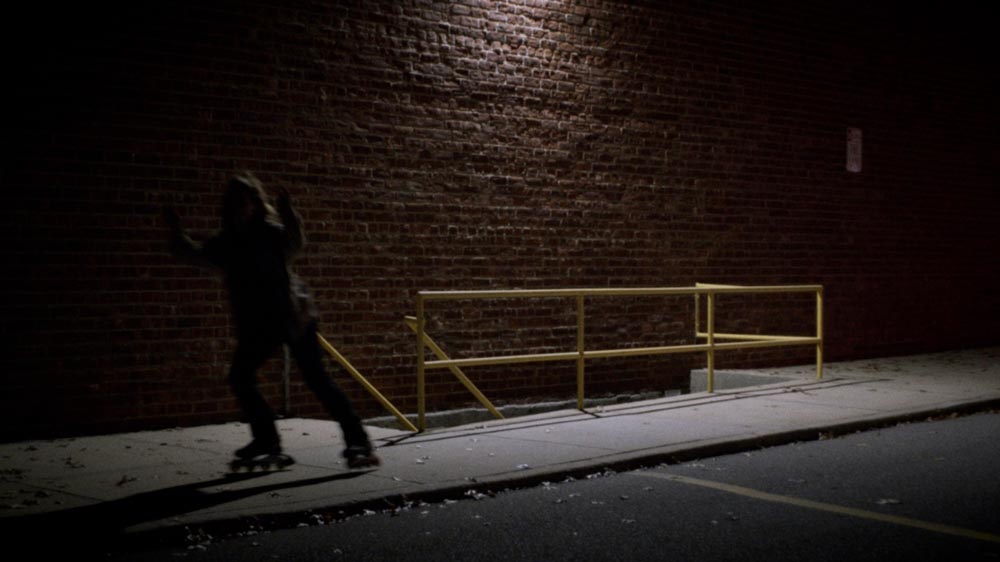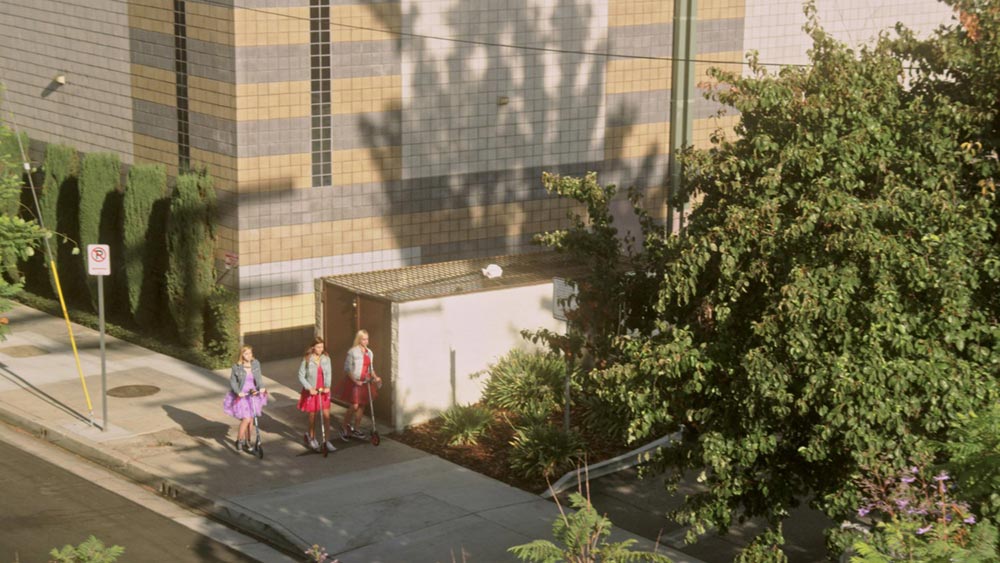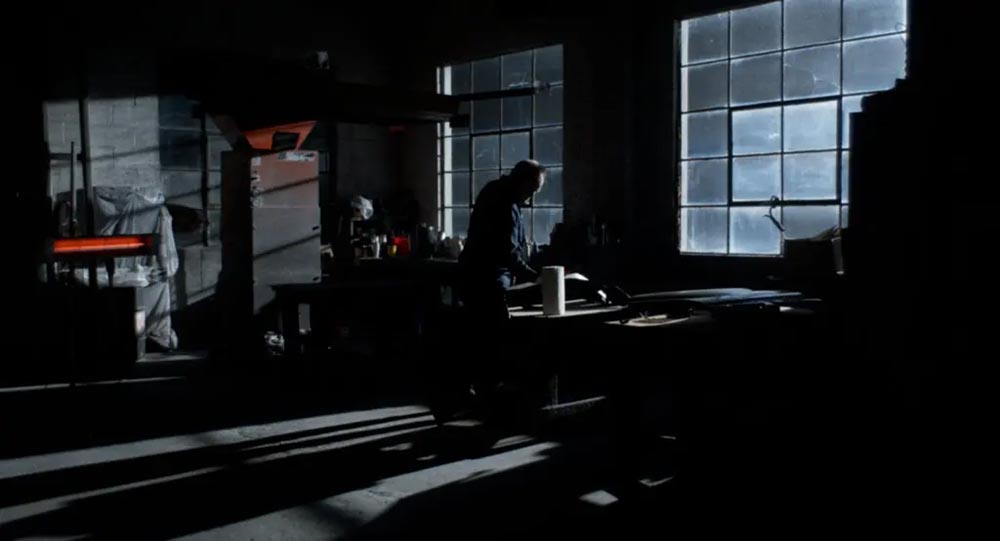Following his acclaimed debut, Ham on Rye (2019), Tyler Taormina’s sophomore featurette, Happer’s Comet (2022), is a midnight mosaic that reveals a suburban town steeped in alienation. Dream-like and dialogue-less, the film presents a number of characters escaping into the silent dark on rollerblades, searching for each other. Mysterious, magical things begin to blossom. Taormina shot the film mid-pandemic, just months after moving back into his childhood home on suburban Long Island.
The only dedicated crew on Happer’s Comet were Taormina and his director of photography, Jesse Sperling. Otherwise, Taormina’s, aunts, uncles, cousins, friends, and neighbors lent a hand. Many of them also appear in the movie, along with a few hired actors, found on the internet.
Happer’s Comet captures the isolation of the pandemic, but also the quiet melancholy of the suburbs, the everyday banality of middle-class America, that of walking through quiet neighborhoods late at night, after a light rain, feeling like an intruder just for being there, on those streets without sidewalks.
The film premiered last year at the 72nd Berlinale, followed by screenings at BAMCinemaFest. It returns to BAM today for a week-long run, including Q&As Friday, June 16, moderated by Michael Cera, and Saturday, June 17.

Samuel Brodsky: Happer’s Comet is a Covid film, but it's also not. You made it at the peak of Covid in 2020, soon after you had moved in with your parents. A lot has changed since then. I'm curious how you see the movie now, three years after you finished production on it, three years out of the worst months of the pandemic. Do you see the film as a kind of time capsule of that time? And is it a film defined by Covid?
Tyler Taormina: Well, this is a type of film that I was always interested in making. And I think the pandemic freed me to make it. There's a pressure in bringing a feature film out into the world, putting your name on it, getting people to see it, et cetera. It’s a big event, you know, it's got to be a big thing. “It has to be bigger than the last one.” But I think that Covid actually freed me [to be] able to make a very small film, an ambitious film in a way, but still a small film, in a way that showed me that I love doing this. I love making a film with two people on the crew. You can do a lot, if you have the time. So it became the impetus for me to work in a different modality, which I know I'll continue to work on.
As far as it being representative of the pandemic era: the pandemic really heightened something that we already experienced in the U.S., during these modern times, which is a specific form of alienation—that is, people becoming more and more atomized. The lockdown period specifically brought a lot of those emotions to an exacerbated level, so making a film about those emotions suddenly became relatable to all. I already had this idea for a movie before the pandemic, but I guess Covid allowed me the permission to make it in a weird way.
SB: Something that I love about your movies specifically is that they are very formalistic and kind of meditative. But you never sacrifice a keen sense of humor. You know, there's that moment in Ham on Rye when the teens are hanging out at a parking lot, they’re brooding about something—we’re not sure what—and then they ride off on hoverboards. And there's that moment in Happer’s Comet where one of the guys suddenly starts doing push ups. I remember everyone cracking up at that scene during BAMCinemaFest last year. I’m curious: How do you balance those two modes? And is that a conscious part of your process of imbuing humor into these slow, meditative films?
TT: Yeah, humor really drives me. I think that every film I do is affectionate. That's maybe the first word I could think of to describe what I like to do, what I like to watch, how I like to live, affection. That's where my favorite sense of humor is found, in affection. So I really think this comes very naturally. People naturally have a sweetness and a humor, and I like to explore that.
SB: You're never making fun of your characters.
TT: Yeah, we're all having fun together. But another thing that I can't really escape is sadness, as well. That's just always gonna be there.
SB: On that topic of sadness and being atomized: all your films take place in the American suburbs. You grew up in a suburb on Long Island, and Happer’s Comet takes place there, as does Christmas Eve in Miller’s Point, which you just finished production on. What is your interest in that place aside from the personal connection?
TT: Of course there's the personal connection. There's the feeling of nostalgia with the suburbs. And, because of that, I have a keen awareness of how it works and how it feels, which makes it comfortable to work in. But suburbia is so interesting because it's really how the American ideology of the 21st century manifested itself through the design of the country. The way in which the brain and heart of America wants to live is evident in the way that suburbia is laid out. And we live through that structure. We are prone to live a certain way which is basically a total disregard for public living altogether, and even the disregard for something spiritual— whatever you could define as a spiritual thing, if it's just simply defined as that thing that is not necessary in life but we enjoy anyways, that extra thing. And that is missing from the suburbs.
SB: There’s a lot of beauty in the suburbs too, though, no?
TT: It's interesting that you bring that up. Sometimes I ask myself, What's our responsibility? Is it to find beauty in a disgusting world or to change that world? I'm really not sure.

SB: What about the sound design of Happer’s Comet? It’s a very sound-centric film, and I understand you come from music.
TT: No sound recorded on set. Most of the sound effects were ripped from YouTube. I was mining for cartoonish noises to push the artifice and render a more dreamlike film. I also quite enjoyed experimenting with music fx pedals like tremolo, reverb and delay, running tracks of my sound design through them and live modulating them.
SB: You also spearhead the film collective Omnes, which you started with your college friends. You guys recently premiered a film on Mubi, Topology of Sirens (2021), and you also recently wrapped production on Carson Lund's film Eephus. And they're all, I think, working in a unique mode in the American indie sphere. You’ve coined a kind of style, or kind of movie that you want to make and want to see called the ecosystem film. Can you elaborate on that term?
TT: Not all of the Omnes projects are ecosystem films, but Eephus, which we just wrapped, was ecosystem through and through. Carson Lund [Ham on Rye’s DP and director of Eephus] and I really have a very separate and similar shared sensibility that we both brought in. When we met each other we both sensed it in the other. But what really ties us together, other than the fact that we're friends, is that we're really interested in seeing new things. We really are interested in making films that are totally unique, and not just tired continuations of these American trends we've seen.
SB: But there's also a specific interest in large ensemble casts, as opposed to individual character studies. And the use of old Hollywood camera work or, a visual style that kind of harks back to a studio-system thing.
TT: Yeah. I'm very interested in seeing the sensibilities of modern and even experimental cinema. To name a few great people working right now: Lucrecia Martel, Pedro Costa, Apichatpong Weerasethakul, Albert Serra. Personally, I’m interested in those voices and merging them with a more classical cinema vocabulary.
SB: It’s impressive how much you do with so little. Few people would think of making a $20,000 debut feature with over 100 actors, shooting in 14 days.
TT: I would be really, really lucky if my true heart of hearts was interested in making films with one or two people in an apartment. But it's just not the case. I can't really bring myself to care about a film with a protagonist that we're just trying to figure out what's on their mind and what their life is like. I think my tastes and sensibilities are drawn toward big canvases, and I have a maximalist mind, because I really like what you can find and gather, assess and analyze through a ton of detail, all the different lines you could draw, because I'm interested in capturing value. And I love the idea of the collective protagonist. That's where I find my excitement, and it’s an unexplored territory that I'm very interested in checking out more.
SB: You had significantly more resources on the film you just finished shooting, Christmas Eve in Miller’s Point. How did that feel, going from making an absolutely no-budget film with Happer’s Comet to a film with significant support?
TT: I had these first two films to prepare me, and I produced two other features. But still, I didn't have any idea what I was in. I had never experienced that before. That was truly crazy. Cinema is really at a point where once you hit [what has been] classically considered a very low budget of like $2 to 3 million you suddenly have so much more responsibility, against all odds, to make that money back. And very few do. And if you make a film for no money, you have to have insane powers of persuasion and get people to do things for nothing. So, no matter the budget you always have complications, challenges.
Happer’s Comet opens tonight, June 16, at BAM and runs through June 22. Director Tyler Taormina will be in attendance tonight and tomorrow, with tonight’s conversation moderated by the actor Micahel Cera.



